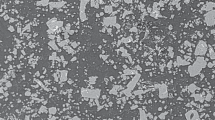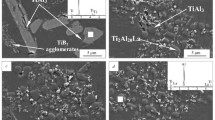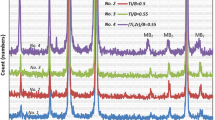Abstract
A comparative study on the influence of fabrication methods of AlTi4 master alloys on the grain size of Al3Ti intermetallic compounds is performed. It is found that an increase in the cooling rate during the solidification from 10–15 K/s (the crystallization in a hot cast iron mold and plate 30 mm in thickness) to 60–65 K/s (the crystallization in a cold cast iron chill mold; the rod 20 mm in diameter and 170 mm in length) promotes an increase in length and thickness of needle crystals of intermetallic compounds almost twofold (from 397 × 23 to 215 × 13 μm). Herewith, a decrease in electrical conductivity and an increase in the master alloy density in the solid state are observed. The modification of the master alloy melt by the addition of magnesium in an amount of 0.5 wt % determines the formation of homogeneous fine needles of intermetallic compounds 98 × 3 μm in size. The magnesium addition insignificantly decreases electrical conductivity and density when compared with the AlTi4 master alloy crystallized at the same cooling rate (60–65 K/s). The grain refinement of aluminum of the A97 grade and AK9ch alloy (the Al–Si–Mg system) by these foundry alloys with the same amount of introduced titanium (0.01 wt %) exert hereditary influence on the density and electrical conductivity, as well as on the marcograin (A97) and aluminum dendrites (AK9ch). The maximal modifying effect is characteristic of the AlTi4 master alloy containing magnesium in an amount of 0.5 wt %. Its introduction into the alloy promotes the formation of aluminum dendrites of 10 μm in size in an amount of 1427 pieces/mm2 in the alloy structure. When modifying the AK9ch alloy by the master alloy crystallized with cooling rates of 10–15 K/s, dendrites 28 μm in size in an amount of 672 pieces/mm2 are formed in the alloy structure. It is proposed to use the determination procedures of density and electrical conductivity for the express evaluation of the modifying efficiency of master alloys.






Similar content being viewed by others
Notes
Here and below, contents of components are presented in wt %.
REFERENCES
Sigworth, G. K. and Kuhn, T. A., Grain refinement of aluminum casting alloys, Inter. J. Metalcast. 2007, vol. 1, no. 1, pp. 31–40.
Lakhwinder, S., Geetesh, G., and Rupinderpreet, S., Review of the latest developments in grain refinement. Int. J. Modern Eng. Res., 2012, vol. 2, no. 4, pp. 2724–2727.
Easton, M.A., Qian, M., Prasad, A., and StJohn, D.H., Recent advances in grain refinement of light metals and alloys, Curr. Opin. Solid State Mater. Sci., 2016, no. 20, pp. 13–24.
Lin, S., Aliravci, C., and Pekguleryuz, M.O., Hot-tear susceptibility of aluminum wrought alloys and the effect of grain refining, Metal. Mater. Trans. A, 2007, vol. 38, no. 5, pp. 1056–1068.
Shimin, Li, Kumar, S., and Diran, A., Role of grain refinement in the hot tearing of cast Al–Cu alloy, Metal. Mater. Trans. B, 2013, vol. 44, no. 3, pp. 614–623.
Mil’man, Yu.V., Neikov, O.D., Sirko, A.I., Danilenko, N.I., Samelyuk, A.V., Zakharova, N.P., Sharovskii, A.I., Ivashchenko, R.K., Goncharuk, V.A., and Chaikina, N.G., Structure and properties of Al–Mg alloys depending on scandium and zirconium additions and production methods, Powder Metall. Metal Ceram., 2010, vol. 49, nos. 7–8, pp. 430–437.
Wang Xu, Chen Guoqin, Li Bing, Wu Lianmei, and Jiang Daming, Effects of Sc, Zr and Ti on the microstructure and properties of Al alloys with high Mg content, Rare Met., 2010, vol. 29, no. 1, pp. 66–71.
Shi’ang Zhou, Zhen Zhang, Ming Li, Dejiang Pan, Hailin Su, Xiaodong Du, Ping Li, and Yucheng Wu, Effect of Sc on microstructure and mechanical properties of as-cast Al–Mg alloys. Mater. Design. 2016, vol. 90, pp. 1077–1084.
Kaiser, M.S., Datta, S., Roychowdhury, A., and Banerjee, M.K., Effect of scandium on the microstructure and ageing behaviour of cast Al–6Mg alloy, Mater. Charact., 2008, vol. 59, no. 11, pp. 1661–1666.
Kaiser, M. S., Datta, S., Bandyopadhyay, P. P., Guha, A., Roychowdhury, A., and Banerjee, M.K., Effect of grain refinement through minor additions of scandium and zirconium on the machinability of Al–Mg alloys, J. Inst. Eng. (India): Ser. D, 2013, vol. 94, no. 1, pp. 17–24.
Sigworth, G. K., The modification of Al–Si casting alloys: Important practical and theoretical aspects, Int. J. Metalcast., 2008, vol. 2, no. 2, pp. 19–40.
Rathod, N.R. and Manghani, J.V., Effect of modifier and grain refiner on cast Al–7Si aluminum alloy: A review, Int. J. Emerg. Trends Eng. Develop., 2012, vol. 5, no. 2, pp. 574–581.
Fang, Q. and Granger, D., Porosity formation in modified and unmodified A356 alloy castings, AFS Trans., 1989, no. 97, pp. 989–1000.
Zhang, J., Chen, H., Yu, H., and Jin, Y., Study on dual modification of Al–17%Si alloys by structural heredity, Metals, 2015, no. 5, pp. 1112–1126.
Ramachandran, T.R., Sharma, P.K., and Balasubramanian, K., Grain refinement of light alloys, in: 68th WFC–World Foundry Congress, India, Chennai, 2008, pp. 189–193.
Xu, C.X. and Zhang, J.S., Structural heredity of AlTiC master alloys, Mater. Sci. Technol., 2001, no. 9, pp. 166–168.
Zhao, J., Wang, T., Chen, J., Fu, L., an He J., Effect of cooling rate on morphology of TiAl3 particles in Al–4Ti master alloy, Materials, 2017, vol. 10, no. 3, p. 238.
Ding, W., Xia, T., and Zhao, W., Performance comparison of Al–Ti master alloys with different microstructures in grain refinement of commercial purity aluminum. Mater: Struct. Anal. Charact., 2014, vol. 7, no. 5, pp. 3663–3676.
Zhao J., He J., Tang Qi, Wang T., Chen J. Grain refinement efficiency in commercial-purity aluminum influenced by the addition of Al-4Ti master alloys with varying TiAl3 particles. Mater: Phys. Metall. High Perform. Alloys, 2016, vol. 9, no. 11, pp. 1–10.
Lipiński, T., Structure and mechanical properties of Al–12% Si alloy with fast cooling Al–12% Si, Arch. Foundr. Eng., 2008, vol. 8, no. 3, pp. 51–54.
Nikitin, V.I. and Nikitin, K.V., Nasledstvennost’ v litykh splavakh (Heredity in Cast Alloys), Moscow: Mashinostroenie-1, 2005.
Nikitin, K.V., Nikitin, V.I., and Timoshkin I. Yu., Upravlenie kachestvom litykh izdelii iz alyuminievykh splavov na osnove yavleniya strukturnoi nasledstvennosti (Quality Control of Cast Products Made of Aluminum Alloys Based on the Structural Heredity Phenomenon), Moscow: Radynitsa, 2015.
ACKNOWLEDGMENTS
This study was supported by the Ministry of Education and Science of the Russian Federation from Funds Assigned to the Developmental Program of Samara State Technical University as the Supporting Higher School.
Author information
Authors and Affiliations
Corresponding authors
Additional information
Translated by N. Korovin
About this article
Cite this article
Nikitin, K.V., Timoshkin, I.Y. & Nikitin, V.I. Influence of Methods of Producing the AlTi Master Alloy on Its Structure and Efficiency in the Grain Refinement of Aluminum Alloy. Russ. J. Non-ferrous Metals 59, 512–519 (2018). https://doi.org/10.3103/S1067821218050115
Received:
Revised:
Accepted:
Published:
Issue Date:
DOI: https://doi.org/10.3103/S1067821218050115




